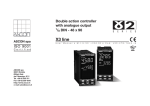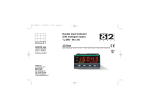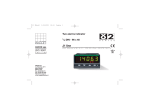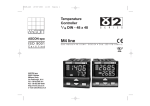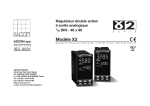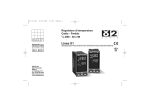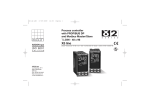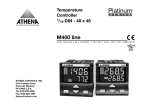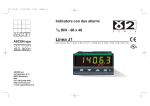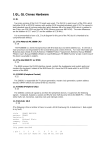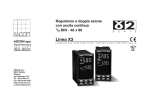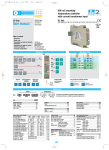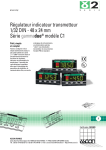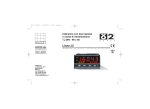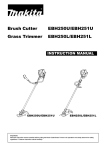Download X1 line - Ascon S.p.A.
Transcript
X1 UK-ed6 19-02-2009 11:50 Pagina 1 Heat / Cool temperature controller 1/ DIN - 48 x 96 8 ASCON spa ISO 9001 C e r t i f i e d ASCON spa 20021 Baranzate (MI) Italy via Falzarego, 9/11 Fax +39 02 350 4243 http://www.ascon.it e-mail [email protected] X1 line User Manual • M.I.U.X1 - 6/09.02 • Cod. J30-478-1AX1 IE c X1 UK-ed6 19-02-2009 11:50 Pagina 1 Heat / Cool temperature controller 1/ DIN - 48 x 96 8 c X1 line X1 45.80 45.80 X1 UK-ed6 19-02-2009 11:50 Pagina 2 Information c NOTES ON ELECTRIC SAFETY AND ELECTROMAGNETIC COMPATIBILITY Please, read carefully these instructions before proceeding with the installation of the controller. Class II instrument, rearl panel mounting. This controller has been designed with compliance to: Regulations on electrical apparatus (appliance, systems and installations) according to the European Community directive 73/23/EEC amended by the European Comunity directive 93/68/EEC and the Regulations on the essential protection requirements in electrical apparatus EN61010-1 : 93 + A2:95. Regulations on Electromagnetic Compatibility according to the European Community directive n089/336/EEC, amended by the European Community directive No. 92/31/EEC, 93/68/EEC, 98/13/EEC and the following regulations: Regulations on RF emissions EN61000-6-3 : 2001 residential environments EN61000-6-4 : 2001 industrial environments Regulation on RF immunity EN61000-6-2 : 2001 industrial equipment and system It is important to understand that it’s responsibility of the installer to ensure the compliance of the regulations on safety requirements and EMC. The device has no user serviceable parts and requires special equipment and specialised engineers. Therefore, a repair can be hardly carried on directly by the user. For this purpose, the manufacturer provides technical assistance and the repair service for its Customers. Please, contact your nearest Agent for further information. All the information and warnings about safety and electromagnetic compatibility are marked with the B sign, at the side of the note. 2 X1 UK-ed6 19-02-2009 11:50 Pagina 3 Table of contents TABLE OF CONTENTS Resources Operating mode Control Alarms Main universal input PV / SP OP1 PV 12 Retransmission 1 OP2 Auxiliary input 2 AUX Single action OP1 OP2 OP3 OP5 OP4 OP1 OP2 OP3 OP5 1 2 3 4 5 6 7 INSTALLATION ...................................................Page ELECTRICAL CONNECTIONS .............Page PRODUCT CODING ......................................Page OPERATIONS ......................................................Page DISPLAYS ...............................................................Page COMMANDS ........................................................Page TECHNICAL SPECIFICATIONS ...........Page 4 8 16 21 47 48 52 OP3 (option) OP4 3 OP1 OP2 OP3 OP5 OP5 Double 4 action OP1 OP4 OP2 OP3 OP5 (option) 5 OP4 OP2 OP1 OP3 OP5 X1 Setpoint Special functions (option) Fuzzy tuning with automatic selection Modbus RS485 Parameterisation Supervision (option) One shot Auto tuning One shot Natural Frequency 3 X1 UK-ed6 19-02-2009 11:50 Pagina 4 1 - Installation 1 INSTALLATION Installation must only be carried out by qualified personnel. 1.1 GENERAL DESCRIPTION IP 20 Terminal block EN61010 - 1 (IEC1010 - 1) Panel surface Before proceeding with the installation of this controller, follow the instructions illustrated in this manual and, particularly the installation precautions marked with the B symbol, related to the European Community directive on electrical protection and electromagnetic compatibility. B To prevent hands or metal touching parts that may be electrically live, the controllers must be installed in an enclosure and/or in a cubicle. Product code label Mounting clamps Sealing front panel gasket Front panel IP65 protection EN 650529 (IEC 529) 4 X1 UK-ed6 19-02-2009 11:50 Pagina 5 1 - Installation 1.2 DIMENTIONAL DETAILS 1.3 PANEL CUT-OUT 48 mm 1.89 in 65 mm min 2.56 in min 110 mm 4.33 in 10 mm max 0.39 in max 92+0.8 mm 3.62+0.031 in 10 mm max 0.39 in max 113 mm min 4.45 in min 96 mm 3.78 in 45+0.6 mm 1.78+0.023 in 5 X1 UK-ed6 19-02-2009 11:50 Pagina 6 1 - Installation B 1.4 ENVIRONMENTAL RATINGS Operating conditions M T %Rh Altitude up to 2000 m Temperature 0…50°C [1] Relative humidity 5…95 % non-condensing Suggestions Special conditions M T %Rh P Altitude > 2000 m Temperature >50°C 6 C E Use forced air ventilation Humidity > 95 % Warm up Conducting atmosphere Use filter Forbidden Conditions UL notes [1] Operating surrounding temperature 0…50°C Use 24Vac supply version D Corrosive atmosphere Explosive atmosphere X1 UK-ed6 19-02-2009 11:50 Pagina 7 1 - Installation 1.5 PANEL MOUNTING [1] 1.5.1 INSERT THE INSTRUMENT 1.5.2 INSTALLATION SECURING 1.5.3 CLAMPS REMOVING 1.5.4 INSTRUMENT UNPLUGGING 1 Prepare panel cut-out 2 Check front panel gasket position 3 Insert the instrument through the cut-out 1 1 Fit the mounting clamps 2 Push the mounting clamps towards the panel surface to secure the instrument 1 Insert the screwdriver in the clips of the clamps 2 Rotate the screwdriver 1 Push and 2 pull to remove the instrument B Electrostatic discharges can damage the instrument 1MΩ 1 Before removing the instrument the operator must discharge himself to ground 1 2 3 2 2 1 UL note [1] For Use on a Flat Surface of a Type 2 and Type 3 ‘raintight’ Enclosure. 1 2 1 7 X1 UK-ed6 19-02-2009 11:50 Pagina 8 2 - Electrical connections ELECTRICAL CONNECTIONS RS485 2 1 13 N/C 25 L 2 14 N/C 26 N C 3 TA 27 16 N/C 28 NC 5 N/C 17 N/C 29 C 6 N/C 18 N/C 30 NO 7 N/C 19 8 20 9 21 N/C 10 mV TC 11 12 A b B OP5 23 24 31 NO 2 26 0,5 Nm Rear terminal cover 35 C 36 24 screw terminals M3 28 Option terminals 29 OP1 Tightening torque 0.5 Nm OP2 30 Phillips screw-driver PH1 OP4 24V— OUT 5.7 mm 0.22 in Wire size 1 mm2 [2] 27 32 C 34 NO REM 25 OP3 33 NO 22 N/C RTD 1 3 15 N/C 4 N/C B 2.1 TERMINATION UNIT [1] 8 19 31 20 32 Flat blade screw-driver 0.8 x 4 mm Terminals UL notes [1] Use 60/70 °C copper (Cu) conductor only. [2] Wire size 1mm2 (18 AWG Solid/Stranded) 8 9 33 10 34 11 23 35 12 24 36 Pin connector q 1.4 mm 0.055 in max. Ø L Fork-shape AMP 165004 Ø 5.5 mm - 0.21 in Stripped wire L 5.5 mm - 0.21 in X1 UK-ed6 19-02-2009 11:50 Pagina 9 2 - Electrical connections B PRECAUTIONS Despite the fact that the instrument has been designed to work in an harsh and noisy environmental (level IV of the industrial standard IEC 801-4), it is recommended to follow the following suggestions. Conduit for supply and output cables A A All the wiring must comply with the local regulations. The supply wiring should be routed away from the power cables. Avoid to use electromagnetic contactors, power Relays and high power motors nearby. Avoid power units nearby, especially if controlled in phase angle Keep the low level sensor input wires away from the power lines and the output cables. If this is not achievable, use shielded cables on the sensor input, with the shield connected to earth. B 2.2 SUGGESTED WIRES ROUTING B A 1 25 1 25 2 26 2 26 3 27 3 27 28 28 29 29 30 E C 30 19 31 20 32 8 9 33 9 10 34 10 8 19 31 20 32 33 23 35 11 23 35 12 24 36 12 24 36 E E C A= B= C= D= E= 34 11 D B D Power Supply Outputs Analogue inputs Analogue output Digital I/O and Serial Comm.s E Conduit for low level sensor cables 9 X1 UK-ed6 19-02-2009 11:50 Pagina 10 2 - Electrical connections B 2.3 EXAMPLE OF WIRING DIAGRAM (HEAT / COOL CONTROL) V~ Retransmission Commands Power supply [3] switch RS485 PTC 1 2 25 26 3 C 27 OP3 Alarm 28 29 [6] 30 OP1 19 8 [5] 31 OP5 [5] Heating 20 32 [6] 9 OP2 10 33 V~ [5] 34 11 23 35 12 24 36 Cooling CT Current transformer 50 mA ~ 10 V~ [6] Notes: 1] Make sure that the power supply voltage is the same indicated on the instrument. 2] Switch on the power supply only after that all the electrical connections have been completed. 3] In accordance with the safety regulations, the power supply switch shall bring the identification of the relevant instrument. The power supply switch shall be easily accessible from the operator. 4] The instrument is is PTC protected. In case of failure it is suggested to return the instrument to the manufacturer for repair. 5] To protect the instrument internal circuits use: - 2 AT fuse for Relay outputs (220 Vac); - 4 AT fuse for Relay outputs (110 Vac); - 1 AacT fuse for Triac outputs. 6] Relay contacts are already protected with varistors. Only in case of 24 Vac inductive loads, use model A51-065-30D7 varistors (on request) X1 UK-ed6 19-02-2009 11:50 Pagina 11 2 - Electrical connections 2.3.1 POWER SUPPLY B Switching power supply with multiple isolation and internal PTC • Standard version: nominal voltage: 100...240Vac (-15...+10%) Frequency 50/60Hz • Low Voltage version: Nominal voltage: 24Vac (-25...+12%) Frequency 50/60Hz or 24Vdc (-15...+25%) Power consumption 4W max. Included PTC 25 L 26 N Supply 27 For better protection against noise, it is recommended not to connect the earth clamp provided for civilian installations. B 2.3.2 PV CONTROL INPUT A L-J-K-S-R-T-B-N-E-W thermocouple type • Connect the wires with the polarity as shown • Use always compensation cable of the correct type for the thermocouple used • The shield, if present, must be connected to a proper earth. 11 12 Wire resistance 150Ω max. B For Pt100 resistance thermometer • If a 3 wires system is used, use always cables of the same section (1mm2 min.) (line 20 Ω/lead maximum resistance) • When using a 2 wires system, use always cables of the same diameter (1,5mm2 min.) and put a jumper between terminals 11 and 12 C For ∆T (2x RTD Pt100) Special A When the distance between the controller and the sensor is 15 m using a cable of 1.5 mm2 section, produces an error on the measure of 1°C. R1 + R2 must be <320Ω A b B A 10 11 12 10 R1 B 11 R2 A For 3 wires only Maximum line resistance: 20Ω/line 12 Use wires of the same length and 1.5 mm2 size. Maximum line resistance: 20Ω/line 11 X1 UK-ed6 19-02-2009 11:50 Pagina 12 2 - Electrical connections B 2.3.2 PV CONTROL INPUT D For mA, mV D2 With 3 wires transmitter Transmitter mV mA 11 36 24V– PV [1] B 2.3.3 AUXILIARY INPUT A - From Remote Setpoint (option) Current 0/4…20mA Input resistance = 30Ω mA External shunt 2.5Ω 12 4…20mA 12 load Voltage 1…5V, 0…5V, 0…10V Input resistance = 300kΩ 8 9 10…100A 50/100mA 23 D1 With 2 wires transmitter Transmitter 4…20mA 36 24V– [1] mA 11 External shunt 2.5Ω 12 [1] Auxiliary power supply for external transmitter 24Vdc ±20%/30mA max. with no short-circuit protection Rj 24 mV-V mA B- For Current Transformer CT not isolated For the measure of the load current (see page 45) • Primary coil10A…100A • Secondary coil 50mA default 100mA S3 internal jumper selectable 12 CT ~ External shunt 2.5Ω Rj >10MΩ PV 11 5 watt burden resistor 0.5Ω for 1A secondary transformer coil 0.1Ω for 5A secondary transformer coil S3 Jumper for 100 mA secondary transformer coil X1 UK-ed6 19-02-2009 11:50 Pagina 13 2 - Electrical connections B 2.3.5 OP1 - OP2 - OP3 - OP4 - OP5 OUTPUTS (OPTION) The functionality associated to each of the OP1, OP2 and OP3 output is defined during the configuration of the instrument index n(see page 19). The suggested combinations are: Control outputs Heat Cool A B Single action C D Double action E AL1 OP1 OP4 OP1 OP1 OP2 OP1 OP4 OP4 OP2 Alarms AL2 AL3 Retransmission PV / SP OP2 OP3 OP5 OP2 OP3 OP5 OP3 OP5 OP3 OP5 OP3 OP5 OP2 OP1 where: OP1 - OP2 OP3 OP4 OP5 Relay or Triac output Relay output (for AL3 only) SSR drive control or Relay output Retransmission analogue output 13 X1 UK-ed6 19-02-2009 11:50 Pagina 14 2 - Electrical connections 2.3.5-A SINGLE ACTION RELAY (TRIAC) CONTROL OUTPUT B 2.3.5-C SINGLE ACTION ANALOGUE OUTPUT [1] OP1 2.3.5-B SINGLE ACTION SSR DRIVE B CONTROL OUTPUT 2.3.5-D Static Relay Coil of the cool load contactor DOUBLE ACTION RELAY (TRIAC)/RELAY (TRIAC) CONTROL OUTPUT 31 OP1 Load Relay output • SPST Relay N.O., 2A/250 Vac (4A/120Vac) for resistive load; • Fuse 2AT at 250Vac, 4AT at 110Vac. Logic output not isolated • 0…5Vdc, ±20%, 30 mA max. [1] 33 Fuse 34 [1] B Static Relay OP4 32 35 35 Cool load Coil of the heat load contactor 2.3.5-E DOUBLE ACTION RELAY (TRIAC)/SSR DRIVE CONTROL OUTPUT 34 Static relay B Fuse 32 OP2 OP4 35 14 OP2 Coil of the heat load contactor Coil of the heat load contactor OP4 32 [1] 32 32 34 Fuse 31 31 OP1 B Fuse Fuse [1] 33 Heat load Coil of the cool load contactor X1 UK-ed6 19-02-2009 11:50 Pagina 15 2 - Electrical connections B 2.3.6 ALARM OUTPUTS A The relay/triac output OP1, OP2 and OP3, can be used as alarm outputs only if they are not used as control outputs. 2.3.7 OP5 ANALOGUE RETRANSMISSION B OUTPUT (OPTION) 19 mA OP5 2.3.8 SERIAL COMMUNICATIONS B (OPTION) 1 Load 20 2 Fuse 31 OP1 OP2 3 C AL1 load [1] V~ 32 AL2 load [1] 33 For PV/SP retransmission only: • Galvanic isolation 500Vac/1 min • 0/4…20mA, (750Ω or 15Vdc max.) Fuse Fuse 28 C V~ 29 [1] NO AL3 load [1] OP3 1 2 3 4 NC • Galvanic isolation 500Vdc/1 min Compliance to the EIA RS485 standard for Modbus/Jbus • Setting dip switches AL3 load 30 Fuse A Please, read: gammadue® and deltadue® controller series serial communication and configuration [1] Varistor for inductive load 24Vdc only 15 X1 UK-ed6 19-02-2009 11:50 Pagina 16 3 - Product coding 3 PRODUCT CODING The complete code is shown on the instrument label. The informations about product coding are accessible from the front panel by mean of a particular procedure described at section 5.2 page 47 Configuration code (software) Basic product code (hardware) O P Q R L M N B C D X1 Instrument label 3150 Hard P/N CONF S/N V~(L-N) 16 : X1-3150-0000 : 0320-2301 : A0A-9909/0013 : 100÷240V 50/60 Hz - 4W X1 UK-ed6 19-02-2009 11:50 Pagina 17 3 - Product coding 3.1 MODEL CODE The product code indicates the specific hardware configuration of the instrument, that can be modified by specialized engineers only. Line Mod.: X 1 Basic Accessories A B C D - E F G 0 / Line Configuration 1st part 2nd part I L M N - O P Q R X 1 Power supply 100...240Vac (-15...+10%) 24Vac (-25...+12%) or 24Vdc (-15...+25%) A 3 5 Special function Not fitted Start-up + Timer E 0 2 Outputs OP1 - OP2- OP4 Relay - Relay - SSR Drive Triac - Triac - SSR Drive Relay - Relay - Relay B 1 5 9 User manual Italian/English (std) French/English German/English Spanish/English F 0 1 2 3 Serial Communications None RS485 Modbus/Jbus SLAVE C 0 5 Front panel colour Dark (std) Beige G 0 1 Options None Analogue output + Remote Setpoint D 0 5 17 X1 UK-ed6 19-02-2009 11:50 Pagina 18 3 - Product coding 3.2 CONFIGURATION CODING A 4+4 index code follows the model of the controller. The code has to be set to configure the controller (see chapter 3.1 page 17) Index I L M N 1st part of configuration mode 0320 Con.1 E.g. Enter the code 0320 to choose: - T/C type J input with range 0...600°C - Single P.I.D. control algorithm, reverse action - Relay output Index O P Q R 2nd part of configuration mode 2301 Con.2 E.g. Enter the code 2301 to choose: - AL1 absolute, active high - AL2 absolute, active low - AL3 Used by Timer - Local + 2 Stored Setpoints with tracking function 18 Input type and range TR Pt100 IEC751 TR Pt100 IEC751 TC L Fe-Const DIN43710 TC J Fe-Cu45% Ni IEC584 TC T Cu-CuNi TC K Chromel-Alumel IEC584 TC S Pt10%Rh-Pt IEC584 TC R Pt13%Rh-Pt IEC584 TC B Pt30%Rh Pt6%Rh IEC584 TC N Nichrosil-Nisil IEC584 TC E Ni10%Cr-CuNi IEC584 TC NI-NiMo18% TC W3%Re-W25%Re TC W5%Re-W26%Re Dc input 0…50mV linear Dc input 10…50mV linear Custom input and range [1] L 0 1 2 3 4 5 6 7 -99.9…300.0 °C -200…600 °C 0…600 °C 0…600 °C -200 …400 °C 0…1200 °C 0…1600 °C 0…1600 °C -99.9…572.0 °F -328…1112 °F 32…1112 °F 32…1112 °F -328…752 °F 32…2192 °F 32…2912 °F 32…2912 °F I 0 0 0 0 0 0 0 0 0…1800 °C 32…3272 °F 0 8 0…1200 °C 32…2192 °F 0…600 °C 32…1112 °F 0…1100 °C 32…2012 °F 0…2000 °C 32…3632 °F 0…2000 °C 32…3632 °F Engineering and units Engineering and units 0 1 1 1 1 1 1 1 9 0 1 2 3 4 5 6 [1] For instance, other thermocouples types, ∆T (with 2 PT 100), custom linearisation etc. X1 UK-ed6 19-02-2009 11:50 Pagina 19 3 - Product coding Engineering and units ON-OFF reverse action ON-OFF direct action P.I.D. single reverse action P.I.D. single direct action P.I.D. double action Output configuration Single action Relay (OP1) SSR drive or relay (OP4) - Linear cool output ON-OFF cool output Water cool output [2] Oil cool output [2] Double action Heat OP1, Cool OP2 Heat OP1, Cool OP4 Heat OP4, Cool OP2 M 0 1 2 3 4 5 6 7 N 0 1 2 [2] In consideration of the thermal characteristics of the different cooling liquids, 2 different correcting methods of the control output are available. One for water and the other for oil OP water = 100•(OP2/100)2 OP oil = 100•(OP2/100)1,5 [3] Only possible whether "Output configuration" n= 0 or 1) and meter is different to OFF, see page 29) HT.FS . . para- Alarm 1 type and function Disabled Sensor break/Loop break alarm (LBA) active high Absolute active low active high Deviation active low active out Band active in active during ON output state Heater break by CT [3] active during OFF output state O 0 1 2 3 4 5 6 7 8 9 Alarm 2 type and function Disabled Sensor break/Loop break alarm (LBA) active high Absolute active low active high Deviation active low active out Band active in active during ON output state Heater break by CT [3] active during OFF output state P 0 1 2 3 4 5 6 7 8 9 19 X1 UK-ed6 19-02-2009 11:50 Pagina 20 3 - Product coding Alarm 3 type and function Disabled or used by Timer Sensor break/Loop break alarm (LBA) active high Absolute active low active high Deviation active low active low Band active in active during ON output state Heater break by CT [3] active during OFF output state Q 0 1 2 3 4 5 6 7 8 9 Setpoint type Local only Local and 2 tracking stored Setpoints Local and 2 Stand-by stored Setpoints Local and Remote Local with trim Remote with trim R 0 1 2 3 4 5 20 X1 UK-ed6 19-02-2009 11:50 Pagina 21 4 - Operations 4 OPERATIONS 4.1.1 KEYS FUNCTIONS AND DISPLAY IN OPERATOR MODE X1 8 Status LEDs (greens) } Communications running Ä Tuning running Ö Timer running Ü Remote Setpoint active ú First stored Setpoint active ù Second stored Setpoint active 45.80 45.80 PV control input in engineering units Over range Under range ____ 8888 8888 ---SP operating Setpoint (Local/Remote or Stored) Control output LEDs (red) å OP1/OP4 ON - ç OP2/OP4 OFF Alarm status LEDs (reds) Å AL1 ON Ç AL2 ON É AL3 ON Entry key for selection and value setting confirmation Setpoint setting Menu access 21 X1 UK-ed6 19-02-2009 11:50 Pagina 22 4 - Operations 4.1.2 KEYS FUNCTIONS AND DISPLAY IN PROGRAMMING MODE A The parameter setting procedure has a timeout. If no keys are pressed for, at least, 30 seconds, the controller switches back, automatically, to the operator mode. X1 35.0 P.b. Parameter value Parameter mnemonic After having selected the parameter or the code, press $ and % to display or modify the value (see page 23) The value is entered when the next parameter is selected, by pressing the è key. Until the $ or % are pressed or if you wait for 30 seconds the parameter value is not inserted Pressing the í key, the next group of parameters is presented on the display. 22 Entry key for selection and value setting confirmation Value modification Access to the menu for: Parameter setting Configuration X1 UK-ed6 19-02-2009 11:50 Pagina 23 4 - Operations 4.2 PARAMETER SETTING 4.2.1 NUMERIC ENTRY (i.e. the modification of the Setpoint value from 275.0 to 240.0 ) Press $ or % momentarily to change the value of 1 unit every push Continued pressing of $ or % changes the value, at rate that doubles every second. Releasing the button the rate of change decreases. In any case the change of the value stops when it has reached the max./min limit set for the parameter. In case of Setpoint modification: press $ or %once to display the local Setpoint instead of working Setpoint. To evidence this change the display flashes once. Then the Setpoint can be modified 274.8 275.0 Operator mode working Setpoint displayed 274.8 Local Setpoint display 275.0 ————Decrease 274.8 230.0 Setpoint modification ————Increase 4.2.2 MNEMONIC CODES SETTING (e.g. configuration see page 28) Press the $ or % to display the next or previous mnemonic for the selected parameter. Continued pressing of $ o r% will display further mnemonics at a rate of one mnemonic every 0.5 s. The mnemonic displayed at the time the next parameter is selected, is the one stored in the parameter. °C Unit °f Engineering Units Degree Centigrade Degree Fahrenheit Degree Fahrenheit Unit none no units defined Unit Unit 274.8 °f 240.0 after 2 s °C 240.0 Setpoint entry. The operation is acknowledged by one flash of the display. °C Unit Degree Centigrade ph Ph Unit 23 X1 UK-ed6 19-02-2009 11:50 Pagina 24 4 - Operations 4.3 PARAMETERISATION - MAIN MENU Back to the Operator mode 274.8 Operator mode 275..0 Setpoint Menu (see page 25) s.p. Menu COMMANDS (if configured) t.run l=r Timer run/stop (see page 49) Setpoint selection local/remote (see page 50) Control Menu (see page 26) Aux. parameters Menu (see page 27) Configuration Menu (see page 28 and 29) Cont Ru.pa Conf Menu Menu Menu Direct access to the parameter (only if Code <5000) Password Entry Only if Code value ≥5000 OPTION (if installed) Must be equal to the value of the parameter Code Stored selection s.sel Setpoint (see page 50 ) 5033 Timer/Start-up Menu (see page 27) pass YES OK Back to the Operator mode 24 NO tM.s.U Menu X1 UK-ed6 19-02-2009 11:50 Pagina 25 4 - Operations 4.3.1 PARAMETERISATION - SETPOINT MENU Menu Setpoint éL.réange s.p. Setpoint low limit low s.p. l range…S.P. Menu H éH.réange é 0 é AIs.p high limit s.p. H Setpoint S.P. L…High range AL1 alarm threshold [1] (see page 30 ) Note [1] It is not presented if the controller has been configured with alarm no. 2 not active or of sensor break type. Digit O/P of the configuration code is assigned to 0 or 1. 0 é A2s.p AL2 alarm threshold [1] (see page 30) 0 alarm threshold [1] A3s.p AL3 (see page 30) é Off sl. u Setpoint ramp up0ff/0.1…999.9 digit/min é Off sl. d Setpoint ramp down OFF/0.1…999.9 digit/min LOCAL, REMOTE, PROGRAMM. configuration index r= O, 3, 6 LOCAL, + 2 STORED. configuration index r= 1, 2 LOCAL OR REMOTE WITH TRIM. configuration index r= 4, 5 é ::::::: é 1.00 s.p. I 1st stored Setpoint é é ::::::: s.p. 2 rtio 1nd stored Setpoint Ratio Setpoint 0 bias Remote Setpoint bias 25 X1 UK-ed6 19-02-2009 11:50 Pagina 26 4 - Operations 4.3.2 PARAMETERISATION - CONTROL MENU Cont Menu Control Menu é 0 é 1:00 t.d. S.Out Derivative time 0ff / 0.01…10.00 min é 1:00 P.I.D. Algorithm On-Off Algorithm O.C. Heat / Cool Algorithm Overshoot control 0.01…1.00 é é Control output hysteresis 0.1...10.0% sc. 0:5 0:5 d.bnd 50 hy. é M.res Manual reset (only with integral time = 0ff) 0.0...100.0% output é tune é 5:0 p.b. é Proportional band 0.5...999.9 of span 5:0 t.i. 26 Integral time 0ff / 0.1…100.0 min é d.Err r.C.G.a Error dead band 0ff/0.1...10.0 digit 20 t.c. é Cycle time (Time proportioning only) 1…200 seconds é100:0 Op. H Control output high limit 10.0…100.0% é Cool output hysteresis (On-Off only) 0.1...10.0% sc 0:5 hy. C Back to the tune parameter Dead band -10.0…10.0% 1:0 é Off Tune run/stop strt / StoP Output safety value 0.0…100.0% (-100.0…100.0% for Heat / Cool) 20 t.c. C é100:0 Op.HC Cool relative gain 0.1…10.0 Cool cycle time (heat/cool time proportioning only) 1…200 seconds Cool control output high limit (P.I.D. only) 10.0…100.0% X1 UK-ed6 19-02-2009 11:50 Pagina 27 4 - Operations 4.3.3 PARAMETERISATION - AUXILIARY PARAMETERS MENU Au.pa Menu é Auxiliary parameters Menu é 1 st.tM 0:5 AL1 hysteresis é Off é 1 Addr LBA delay (see page 38) 0ff= sensor break 1…9999 s LBA éL. réange Soft-start output value ( t.Mod =0ff only) 0ff/0.1…100.0% éH. réange rt.lo. 0:5 Back to the A1hy parameter START-UP FUNCTION (only if t.Mod = 1) TIMER FUNCTION (only with AL3 enabled) Input shift In.sh 0ff/-60…60 digit é OFF St.OP Timer/Start-up operating mode (see table 1 page 41) t.Mod Filter time constant é Off Alarm latching and blocking functions none / Ltch bloc / Lt.bL AL2 and AL3 parameters é Menu Timer and Start-up Menu t.fil OFF/1...30 s énone t.Lba tM.s.U é Off A1hy 0.1…10.0% of span A1L.b Soft-start activation time (only if st.Op different than 0ff) 1…9999 s 4.3.4 PARAMETERISATION - TIMER AND START-UP MENU If options installed rt.hi Communication address (if option installed) 0ff / 1…247 Retransmission low range (only if installed) whole range Retransmission high range (only if installed) whole range é t.Act é 0:5 é tiMe 0 s.p.sb Back to the Timer Action (only if t.Mod not equal to Offor to 1) (see table page 41) Timer setting 1…9999 s or min Stand-by Setpoint (only if t.Mod = 7) S.P. L…S.P. H 1 Hold time é t.h.s.U 0…500 min 0 Start-up Setpoint L…S.P. H s.p.s.U S.P. é100:0 Op.Hs Output high limit during Start-up 5.0…100.0% t.Mod parameter 27 X1 UK-ed6 19-02-2009 11:50 Pagina 28 4 - Operations 4.3.5 CONFIGURATION MENU Enter the password before accessing to the configuration menu. If a not configured controller is supplied, when powered up for the first time, the display shows: 9999 Con.1 Until the configuration code is set correctly, the controller remains in stand-by with input and output deactivated. Index I L M N Conf 1st part of configuration mode 0320 Menu Password Entry Only if Code value <5000 (33 default from factory) Con.1 E.g. Enter the code 0320 to choose: - T/C type J input with range 0...600°C - Single P.I.D. control algorithm , reverse action - Relay output Index O P Q R 33 Must be equal to the value of the parameter Code pass Back to Operator mode YES NO OK é Off 2nd part of configuration mode 2301 Con.2 Entry of digits L-M-N Con.1 Iof- the configuration code (chapter 3.2 pages 18, 19) A 4+4 index code follows the model of the controller. It has to be set to configure the controller. (see chapter 3.1 page 17) 28 E.g. Enter the code 2301 to choose: - AL1 absolute, active high - AL2 absolute, active low - AL3 Used by Timer - Local + 2 Stored Setpoints with Tracking function é Off Entry of digits Q-R Con.2 Oof-theP -configuration code (chapter 3.2 pages 19, 20) énone IL1 digital input Unit function (see table 1) X1 UK-ed6 19-02-2009 11:50 Pagina 29 4 - Operations LINEAR SCALE ONLY of decimals sc.dd No. 0…3 Table 1 SERIAL COM. OPTION (if installed) éM:bus prot Communication protocol M.buS / jbuS Value °C °f none mU U mA A bar psI rh ph é9600 range sc.lo Low -999…9999 baud (min. 100 digit) range sc.Hi High -999…9999 (min. 100 digit) é4=20 Setpoint rs.in Remote input 1200/2400 4800/9600 ANALOGUE OUTPUT OPTION OP5 (if installed) é4=20 retr REMOTE SETPOINT (if configured) Baud rate Analogue control output range 0=20 / 4=20 mA rtH (see table 2) Control output selection P.U. / S.P. CT (only on proportional output other than the servomotor) é Password Ht.f.s CTrangeprimary high Off/1…200 A Table 2 ép:U: 0…9999 33 default from factory Back to the Con.1 parameter Value 33 Code 0=5 1=5 0=10 0=20 4=20 Engineering units éunit Description degree centigrade degree Fahrenheit none mV Volt mA Ampere Bar PSI Rh pH Remote Setpoint input type érs:In Description 0…5 Volt 1…5 Volt 0…10 Volt 0…20 mA 4…20 mA 29 X1 UK-ed6 19-02-2009 11:50 Pagina 30 4 - Operations 4.4 PARAMETERS For a simpler use of the controller, its parameters have been organised in groups (menu), according to their functionality area. 4.4.1 SETPOINT MENU The OP1, OP2 or OP3 outputs, can be used for alarms if they are not used as control outputs It is possible to configure up to 4 alarms: AL1, AL2, AL3, AL4 (see page 19 and 20), selecting, for each of them: A the type and the operating condition of the alarm B the functionality of the alarm acknowledge (latching) # l tch (see page 37) C the start-up disabling (blocking) b # loc (see page 37) D Loop break or sensor break (see page 38) A ALARM TYPE AND OPERATION CONDITIONS Absolute alarm (full scale) On Active Off high On Off Active low hy low range Alarm threshold high range Deviation alarm On Active Off high SP On Off Active low hy - low range Alarm threshold + high range Band alarm SP On Active Off out On Off hy full scale 30 hy alarm threshold Active in full scale # 1s.P A #A2s.P #A3s.P AL1 alarm threshold AL2 alarm threshold AL3 alarm threshold Alarm occurrences of OP1,OP2 and OP3 outputs, respectively linked to AL1, AL2 and AL3. The range of the alarm threshold correspond to the whole span and it is not limited by the SP Setpoint span. When the event occures, the display will shows the red ledsÅ,Ç or É, respectively on. X1 UK-ed6 19-02-2009 11:50 Pagina 31 4 - Operations # l. u s #sl. d Setpoint ramp up Setpoint ramp down This parameter specifies the max.imum rate of change of the Setpoint in digit/min. When the parameter is OFF, this function is disabled and the new Setpoint is reached immediately after being entered. Otherwise, the Setpoint value is reached according to the configured rate of change. When Remote Setpoint is configured, we suggest to disable #sl. u and #sl. d parameters Off. Target Setpoint = 350°C Example Setpoint change Initial Setpoint = 250°C #sL. u = 10 digit/minutes t t = 10 # .P. L S #S.P. H Setpoint low limit Setpoint high limit Low / high limit of the Setpoint value. # .P. 1 S #S.P. 2 1st stored Setpoint 2nd stored Setpoint Preset Set values can be set from the keyboard and serial communication. The Setpoint active is indicated by the ú or ù green led. If index r= 1 (tracking), the previous Local Setpoint value will be lost, when the stored Setpoint is selected. If index r= 2 (Stand-by), the Local Setpoint value will not be lost, when the Stand-by Setpoint is selected. It will operate again when back to Local. See stored Setpoint selection procedure at page 50 The new Setpoint value is called "Target Setpoint". It can be displayed by means the parameter #t.S.P. (see procedure at page 47). 31 X1 UK-ed6 19-02-2009 11:50 Pagina 32 4 - Operations 4.4.1 SETPOINT MENU r # tio Remote Setpoint Ratio Ratio is the coeff. which defines the remote Setpoint span with respect to the input span. Remote Setpoint Bias and Ratio ab bias = 20 ratio = 0.1 10V b # ias Remote Setpoint Bias defines the starting point of analogue Remote Setpoint in eng. units corresponding to the low limit (current or voltage) of the remote signal. biaS= starting point = a a´ b´ bias = 100 ratio = –0.1 rtio= Range -200 LR 0 20 a (b´ ) 100 b (a´ ) 600 °C HR Remote Setpoint span PV = LR = HR = SR = a (a´) = b (b´) = 32 If SR starting point is lower then the ending point, both expressed in engineering units: Remote signal process variable PV low limit PV high limit Remote Setpoint SR starting point SR ending point b-a HR - LR Example: biaS= 20 rtio= 100 - 20 80 = = 0.1 600 - (-200) 800 X1 UK-ed6 19-02-2009 11:50 Pagina 33 4 - Operations If SR starting point is higher then the ending point, both expressed in engineering units Working Setpoint (SP) as combination of Local Setpoint (SL) and remote signal biaS= starting point = a´ b´ - a´ rtio= HR - LR Setpoint type Loc.t (configuration index r= 4 ) SP = SL + (rtio • REM) + biaS Example: biaS= 100 rtio= 20 - 100 - 80 = = - 0.1 600 - (-200) 800 Setpoint type reM.t (configuration index r= 5 ) SP = REM + (rtio • SL) + biaS SIGN = Remote signal percentage SPAN = HR-LR REM = SIGN * SPAN 100 Examples: Local Setpoint (SL) with an external Trim with multiplying coefficient of 1/10: Setpoint type = Loc.t rtio= 0.1 biaS= 0 Remote Setpoint (SR) with an internal Trim with multiplying coefficient of 1/5: Setpoint type = reM.t rtio= 0.2 biaS= 0 Remote Setpoint range equal to the Input range: Setpoint type = Loc.t rtio = 1 biaS= LR SL = 0 33 X1 UK-ed6 19-02-2009 11:50 Pagina 34 4 - Operations 4.4.2 CONTROL MENU t # une 4.4.2.1 Run Tune AUTOMATIC TUNE The Fuzzy-Tuning determines automatically the best P.I.D. term with respect to the process behaviour. the start of the autotune operation, the PV is far from the Setpoint of more than 5% of the span. This method has the big advantage of fast calculation, with a reasonable accuracy in the term calculation. Start/stop of the Fuzzy Tuning The Tuning operation can be started or stopped any time. PV variable End of the tuning operating and setting of the new calculated terms. Control output STEP response SP Setpoint change PV variable End of the tuning operating and setting of the new calculated terms. Start of autotune operation Control output 34 This type is selected when the PV is close to the SP Setpoint. This method has the advantage of a better accuracy in the term calculation with a reasonable speed calculation. 274.8 275..0 Operator mode press until FUZZY-TUNING START/STOP PROCEDURE Natural frequency tuning start The controller provides 2 types of “one shot” tuning algorithm, that are selected automatically according to the process condition when the operation is started. This type is selected when, at The Fuzzy Tuning determines automatically the best method to use to calculate the P.I.D. term, according the process conditions. The green led Ä is ON when the Fuzzy Tuning is in progress. At the end of this operation, the calculated P.I.D. terms parameter are stored and used by the control algorithm and the controller goes back to the operator mode. The green led Ä becomes off. Cont Menu stop tune strt tune Control menu To start select strt To stop select stop X1 UK-ed6 19-02-2009 11:50 Pagina 35 4 - Operations #P.b. Proportional band This parameter specifies the proportional band coefficient that multiplies the error (SP - PV) #t.i. Integral time It is the integral time value, that specifies the time required by the integral term to generate an output equivalent to the proportional term. When Off the integral term is not included in the control algorithm. #t.d. Derivative time It is the time required by the proportional term P to repeat the output provided by the derivative term D. When Off the derivative term is not included in the control algorithm. #O.C. Overshoot control This parameter specifies the span of action of the overshoot control. Setting lower values (1.00 —> 0.01) the overshoot generated by a Setpoint change is reduced. The overshoot control doesn’t affect the effectiveness of the P.I.D. algorithm. Setting 1, the overshoot control is disabled. # .c. t #t.c. C Control output cycle time Cool cycle time It’s the cycle time of the SSR drive control output. The P.I.D. control output is provided by the pulse width modulation of the waveform. # p. H O #Op.C.H Manual Reset This specifies the control output value when PV = SP, in a PD only algorithm (lack of the integral term). Control output high limit Cool output high limit It specifies the maximum value the control output can be set. It is applied in manual mode, too. #d.err #S.Out #M.res Error Dead Band Inside this band for (PV - SP), the control output does not change to protect the actuator (output Stand-by) # y. h #hy. C Control output hysteresis Cool output hysteresis SP On Off hy Control or alarm output hysteresis span, set in % of the full scale. Output Safety Value Output Value in case of input anomaly 35 X1 UK-ed6 19-02-2009 11:50 Pagina 36 4 - Operations 4.4.2 CONTROL MENU 4.4.2.2 HEAT/COOL CONTROL By a sole P.I.D. control algorithm, the controller handles two different outputs, one of these performs the Heat action, the other one the Cool action. It is possible to overlap the outputs. A Heat /Cool actions separated Insert positive d # b . nd value (0…10%) -100% 100% #Op. H #Op.HC C Cool action adjusting Example with different relative cool gains The Cool action can be adjusted using the relative cool gain parameter r # C . G . a. 0% Heat output 100% Cool output 50% -100% #d.bnd #d.bnd The dead band parameter d # b . nd, is the zone where it is possible to separate or overlap the Heat and Cool actions. #r.C.Ga 0.1…10.0 =2.0 =1.0 =0.5 100% 0% 0% PID output B Heat /Cool actions overlapped Insert negative d # b . nd value (-10…0%) Heat output 100% D Cool output 50% 0% PID output On-Off Cool action #hy. C To limit the Heat and Cool outputs the para# p. H and 0 # p.HC can be used. meters 0 When there is an overlap, the displayed output # OUt shows the algebric sum of the Heat and Cool outputs. #Op. H #Op.HC 100% On #d.bnd #d.bnd 0% 100% 36 -100% 100% Heat cool Cool output 50% 0% PID output 0% Heat output 100% Cool output 50% Off 0% PID output X1 UK-ed6 19-02-2009 11:50 Pagina 37 4 - Operations 4.4.3 AUXILIARY PARAMETERS MENU A # Ihy A # 2hy A # 3hy AL1 alarm hysteresis AL2 alarm hysteresis AL3 alarm hysteresis Hysteresis of the threshold of both the alarms, that activate OP1 and OP2 control output. It is specified as a % of the full scale. #AIL.b #A2L.b #A3L.b AL1, AL2, AL3 latching and blocking functions L # tch ALARM ACKNOWLEDGE FUNCTION The alarm, once occurred, is presented on the display until to the time of acknowledge. The acknowledge operation consists in pressing any key. After this operation, the alarm leaves the alarm state only when the alarm condition is no longer present. b # loc START-UP DISABLING Ramp down Disable ∆SP SP On Off Start-up Ramp up SP ∆SP Disable On Off Start-up ∆SP Threshold = SP ± range For each alarm it is possible to select the following functions none none Ltch latching bloc blocking Lt.bL both latching and blocking 37 X1 UK-ed6 19-02-2009 11:50 Pagina 38 4 - Operations 4.4.3 AUXILIARY PARAMETERS MENU ALARMS WITH LBA (LOOP BREAK ALARM) AND SENSOR BREAK OPERATION Select the code 1 on o, p or q configuration indexes (see pages 21 or 22). The following parameter is then available: #t.lba Setting OFF the alarm works as Sensor break with immediate action. This condition is shown by means the red led of the selected alarm as well as: ____ 8888 274.8 275.0 275.0 2 Soft-start control output value Value of the control output during the Soft-start activation time. LBA delay Setting a value between 1 and 9999 s the alarm works as LBA+Sensor break with delay [1] This condition is shown by means a red led as well as the blinking PV display. 1 #st.Op 3 OP1 1 2 3 ---8888 #st.tM Soft-start activation time Time duration (starting from the power on) of the Soft-start function. OP 1 2 3 °C Note [1] In case of sensor break, condition, the alarm action is immediate. When the cause of the alarm disappears, the alarm status stops. 38 Filter response 100% 63,2% #In.sh #St.OP Soft-start mA Input filter time constant Time constant, in seconds, of the RC input filter applied to the PV input. When this parameter is set to Off the filter is bypassed. #St.tM Power on PV 0 t.Fil 100% 275.0 or #t.fil Time Time Input shift This value is added to the measured PV input value. Its effect is to shift the whole PV scale of up to ± 60 digits. X1 UK-ed6 19-02-2009 11:50 Pagina 39 4 - Operations A # ddr Controller address the address range is from 1 to 247 and must be unique for each controller on the communication bus to the supervisor. When set to Off the controller is not communicating # t.lo r #rt.Hi Retransmission low range Retransmission high range 4.4.4 TIMER AND START-UP MENU (OPTION) To improve the instrument performances and to reduce the wiring and installation costs, two special functions are available: 4.4.4.1 Start-up 4.4.4.2 Timer In order to have the above functions the product code digit emust be 2 (see page 19) For example: X3 3100-2000 To select these functions use the parameter: (see page 41). Timer/Start-up operator mode #t.Mod A Selecting Timer or Startup, the Soft-start function is disabled, therefore the parameters # s t. O p and #st.tM will not be shown. (see page 29) 4.4.4.1 START-UP FUNCTION (OPTION) By means of this function it is possible to manipulate the control output when the controller is switched on. 1 t.Mod To configure Startup function the parameter “Timer/Start-up operating mode” must be set to # 1. (see page 41) Three parameters are associated to the Start-up function. #t.h.s.U Start-up hold time 0…500 min #S.P.s.U Start-up Setpoint (S.P. L…S.P. H) #Op.Hs Control output high limit 5.0%…100.0% The Start-up function includes three phases: 1st “Limy” - The control output # p.Hs is limited to the O 2nd “Hold” - The process variable is maintained to the Start-up Setpoint for the time fixed by the parameter t # h . s . U . 3rd “Off” - When the t # h . s . U . time is elapsed the process variable is maintained to the working Setpoint. Whether the process variable, for any reason (e.g. load change), decreases at a value lower than ( s # p . s . U - 40 digits), the Start-up function starts again from the “Limy” phase. 39 X1 UK-ed6 19-02-2009 11:50 Pagina 40 4 - Operations 4.4.4.1 START-UP FUNCTION (OPTION) When the Start-up is in Hold phase, if the local Setpoint becomes lower than the Startup Setpoint or if the operating mode changes to manual, the Start-up function passes to the “Off” phase. There are two possibilities: A Start-up Setpoint #sp.sU lower than the local Setpoint. The “Hold” phase starts when the process variable PV achieves the # s p. s U (with a tolerance of 1 digit). B Start-up Setpoint #sp.sU greater than or equal to the local Setpoint. When the process variable PV achieves the local Setpoint (with a tolerance of 1 digit), the Start-up function passes directly to the “Off” phase. 40 If, at the controller power-on, the process variable PV is greater than # p.sU the lowest between the s and the working Setpoint , the next phase (“Hold” or “Off”) will be executed instead of the “Limy” phase. A power-on noise #t.h.S.U #S.P.S.U 40 digit with TC = 25% 1sec min. 1a “Limy” 2a “Hold” During the “Limy” and “Hold” phases the Ö led is on. #t.h.S.U 1 digit OP=OP.H5 420 Start-up Setpoint Setpoint SP PV 1285 RUN s # P . s . U < local Setpoint SP B 3a “Off” 1a “Limy” 2a “Hold” 3a “Off” s # P . s . U ≥ Setpoint locale SP power-on PV #s.p.s.U 1 digit noise Setpoint SP 40 digit OP=OP.H5 with TC = 25% 1a “Limy” 3a “Off” 1a “Limy” 3a “Off” X1 UK-ed6 19-02-2009 11:50 Pagina 41 4 - Operations 4.4.4.2 TIMER FUNCTION (OPTION) A The Timer can’t be enabled with Heat / Cool control. To enable this function do the following: 1 In order to use this AL3 function, index qmust be set to 0 in configuration (see p. 20). 2 To select one of the 6 possible functioning modes of the Timer, set the value of the 2 following parameters in parameterisation (see p. 27). #t.Mod Timer/Start-up operating mode By this parameter can be defined: (see table 1) - the counting start time - the control output status at the end of the counting table 1 Timer/Start-up counting mode Value Disabled OFF Start-up function 1 Counting End mode start time When inside the Control mode 2 Output to 0 band 3 Control mode 4 When launched Output to 0 5 When launched. Control mod Control disabled 6 When launched Control mod stand-by Setpoint 7 Now the other parameter values can be entered: #t.Act Timer Action By this parameter can be defined:(see table 2) - the time units - the starting mode - the OP3 status when the timer is running. When the timer is not running, the OP3 takes the opposite status. t # iMe Timer setting (1…9999 s/min) #S.P.sb Stand-by Setpoint (only for t.Mod = 7) (S.P. L…S.P. H) table 2 Time units Starting mode Manual by keypad Auto at the power on [2] Manual by keypad Minutes Auto at the power on [2] Seconds [1] OP3 Value status On 0 Off 1 On 2 Off 3 On 4 Off 5 On 6 Off 7 [1] If used by Timer [2] Using this selection, manual starting mode is possible too. 41 X1 UK-ed6 19-02-2009 11:50 Pagina 42 4 - Operations 4.4.4.2 TIMER FUNCTION (OPTION) TIMER COUNTING MODES A - Counting start time inside the band, end in control mode. B - Counting start time inside the band, end with control output forced to zero. C - Counting start time = timer launch time, end in control mode. The time counting starts only when the error is inside a ± 1 digit band. The control action is not affected by the Timer function. The time counting starts only when the error is inside a ± 1 digit band. At the end, the control output is forced to zero. [1] The time counting starts when the timer is launched. The control action is not affected by the Timer function. Timer launch Timer launch #tiMe #t.Mod = 2 Setpoint #tiMe #t.Mod =3 Setpoint Process variable PV ±1 digit band Output OP Process variable PV ±1digit band #t.Mod = 4 Process variable PV Output OP OP3 [1] When the Timer is not running the control output is forced to zero, also before the Timer launch 42 #tiMe Setpoint Output OP OP3 Timer launch OP3 X1 UK-ed6 19-02-2009 11:50 Pagina 43 4 - Operations TIMER COUNTING MODES D - Counting start time = timer launch time, end with control output forced to zero. E - No control action during the counting time. F - Control action with stand-by Setpoint during the counting time The time counting starts when the timer is launched. At the end, the control output is forced to zero [1]. The time counting starts when the timer is launched and the control output is forced to zero. At the end, the control action starts. The time counting starts when the timer is launched and the control action use the Stand-by Setpoint. At the end, the control action use the working Setpoint. Timer launch #tiMe #t.Mod = 5 Setpoint Timer launch #tiMe #t.Mod = 6 Setpoint Process variable PV Output OP OP3 Timer launch #tiMe #t.Mod =7 Setpoint Process variable PV Process variable PV Output OP Output OP OP3 #s.p. 2 OP3 [1] When the Timer is not running the control output is forced to zero, also before the Timer launch 43 X1 UK-ed6 19-02-2009 11:50 Pagina 44 4 - Operations 4.4.4.2 TIMER FUNCTION (OPTION) POWER FAILURE If there is a power failure during the Timer execution, the value of the elapsed time is lost. Depending on Timer action # t . a ct selection, when the controller restarts you can have two different situations: • with automatic mode ( # t . a ct = 2 , 3 , 6 , 7 ), the Timer function starts again and the counting time is reinitialised. • with manual mode # a . ct = 0,1,4,5), the con(t trol output is forced to zero, if #tMod = 3 e 5; otherwise the control action restarts using the working Setpoint 44 850 DISPLAY 850 TIMER STARTING RUN RUN 850 Operator mode and Timer running 850 See the Timer starting procedure at page 49. Press until When the Timer is running, the led Ö is on. 850 234 RUN Remaining time tM.r. End Counting stop When the Timer ends, the Setpoint display shows alterna# nd and tively the message E the Setpoint value until a key is pressed. 234 RUN Value change 60 TIMER REMAINING TIME When the timer is running it is always possible to see the remaining time and to modify it. tM.r. Remaining time value RUN tM.r. If set to # 0 the timer ends X1 UK-ed6 19-02-2009 11:50 Pagina 45 4 - Operations 4.4.5 CONFIGURATION MENU RETRANSMISSION When OP5 output is present, it retransmits linearised PV or SP. On configuration (see page 29) it is possible to set Output range 0=20 / 4=20 r # etr r # tH Retransmitted signal none P.U. / S.P. The following parameters define the low and high range of the OP5 retransmission output corresponding to 0…4mA or 20mA (see page 27): Example: • T/C S, range 0…1600°C • Output range, 4…20 mA • Retransmitted signal PV on 800…1200°C range mA 20 #retr = 4=20 #rt.H = P.U. #rt.Lo = 800 #rt.Hi =1200 4 # t.lo r #rt.Hi Retransmission low range Retransmission high range °C 800 1200 1600 CURRENT TRANSFORMER INPUT With CT option, it is possible to display the load current and set an alarm threshold. The setting can be done by means the 8 or 9 configuration index of the codes O, P or Q (see pages 19 and 20). It is possible to set one of the alarms (see pages 19 and 20) to have an alarm when, during the ON time of the time proportional output, the load current is less then the specified threshold (index 8), or during the OFF time there is a value > 3% of full scale load current. The alarm condition must be longer than 120 ms to set the alarm. By the parameter CT primary high range OFF/ 1…200A the load current display can be adapted to the transformer characteristics. (OFF means disabled) #Ht.f.S During the OFF time the para# C . ur latches the last on meter t time current value rt.lo greater than rt.hi it is possible to obtain With a reverse scale. 45 X1 UK-ed6 19-02-2009 11:50 Pagina 46 4 - Operations 4.4.5 CONFIGURATION MENU CURRENT TRANSFORMER INPUT SERIAL COMMUNICATIONS Example: CT input on OP1, alarm on AL2 during on time (configuration digit p = 8, , see page 19) p # rot Communication protocol M.bus/ j.bus b # aud Baud rate 1200/ 2400 4800/ 9600 120 ms OP1 120 ms OFF ON ON t.Cur Load current A2s.p 3% AL2 46 OFF ON OFF ON OFF X1 UK-ed6 19-02-2009 11:51 Pagina 47 5 - Displays 5 5.1 DISPLAYS OF THE PROCESS VARIABLES 274.8 Operator mode 5.2 274.8 275..0 °C Engineering units (see Table 2 page 29) Manual Local Setpoint modifiable value 274.8 Operator mode 275..0 °C 63.4 OP1 output Out 3150 Hard P.I.D. only Setpoint value 380.0 Target local mode only t.S.P. 33 tM.r. Timer remaining time modifiable value (if option installed, see page 44) 274.8 Engineering units (see table 2 page 29) AUTO 275.0 S.P. OF THE CONFIGURATION CODES 47 t.Cur 2002 Con.1 (not displayed if the Slopes are disabled) Load current in Ampere (CT option only, see page 45) 00A reL. Software release 2321 Con.2 Basic product code (Hardware page 17) 1st part of the configuration code (see pages 18 and 19) 2nd part of the configuration code (see pages 18 and 19) 47 X1 UK-ed6 19-02-2009 11:51 Pagina 48 6 - Commands 6 COMMANDS COMMANDS TO THE CONTROLLER AND OPERATING PHASES The commands can be entered in 2 ways: 6.1 KEYPAD see page 49 • • • • • • 48 Setpoint modification Timer start Local/remote selection Stored Setpoint display Keypad lock Outputs lock 6.2 SERIAL COMMUNICATIONS see the manual on this topic X1 UK-ed6 19-02-2009 11:51 Pagina 49 6 - Commands 6.1 KEYPAD COMMANDS 6.1.1 SETPOINT MODIFICATION The Setpoint is directly modified with the $%keys. Once entered, the new value is checked and becomes operating after 2 seconds.. The end of this phase is flagged by flashing momentarily the display with SP. 6.1.2 TIMER STARTING (option) 274.8 275.0 Operator mode Example of Setpoint modification from 275 to 350 274.8 350.0 Modified Setpoint value Depending on the Timer action #t.act selection, there can be two different starting ways: - Automatic at the power on - Manual by keypad, digital inputs or serial communications. To start/stop the Timer: 350 Operator mode 350 Press until stop t.run To start select strt after 2 seconds 274.8 350.0 Flash momentarily the SP value to confirm that it has become operating. back to the operator mode strt t.run To stop select stop Press the key è to confirm 49 X1 UK-ed6 19-02-2009 11:51 Pagina 50 6 - Commands 6.1 KEYPAD COMMANDS 6.1.3 LOC/ REM SELECTION configuration index r = 4 or 5) Operator mode Press until Loc L=r reM L=r 6.1.4 STORED SETPOINTS SELECTION (configuration index r = 1 or 2) 274.8 274.8 275.0 275.0 Press until Tracking Index r = 1 Select reM to enable Remote Setpoint none Select Loc to enable Local Setpoint S.Sel . Select S.P1 to force the first Setpoint S.P. 1 . Select S.P2 to force the second Setpoint S.Sel The selected Setpoint becomes operating pressing the è When in Remote, the green led Ü is on 50 Select none to free the Setpoint modification, then Press $% to change the local Setpoint Stand-by Index r = 2 Loc S.Sel S.P. 1 S.Sel S.P. 2 S.P. 2 S.Sel S.Sel The selected Setpoint becomes operating pressing the è key. The corrispondig green led (ú or ù) is on Select Loc to come back to the previous local Setpoint value X1 UK-ed6 19-02-2009 11:51 Pagina 51 6 - Commands 6.1.5 KEYPAD LOCK 6.1.6 OUTPUTS LOCK operator mode To lock/unlock the keypad press the keys í and è simultaneously for 2 seconds. To confirm the keypad lock/unlock the display flashes once. X1 45.80 45.80 The keypad lock/unlock can be achieved by serial communications too. operator mode The outputs are switched to the OFF status by pressing the keys í and %together. When the outputs are locked , the message #Off is displayed instead of the Setpoint value. To unlock the outputs press again the keys simultaneously (the Soft-start will be enabled). X1 45.80 Off The outputs lock/unlock can be achieved by serial communications too A The keypad lock is maintained in case of power failure. AThe outputs lock/unlock is maintained in case of power failure. Press simultaneously for 2 seconds Press simultaneously for 2 seconds 51 X1 UK-ed6 19-02-2009 11:51 Pagina 52 7 - Technical specifications 7 TECHNICAL SPECIFICATIONS Features (at 25°C environmental temp.) Description From keypad or serial communication the user selects: Total configurability - the type of input (see chapter 3.2 page 18 - the type of control algorithm chapter 4.3.5 page 28) - the type of output Common characteristics Accuracy PV Input (see pages 11,12 and page 18) Resistance thermometer (for ∆T: R1+R2 must be <320Ω) Thermocouple DC input (current) DC input (voltage) 52 - the type and functionality of the alarms - the type of Setpoint - control parameter values A/D converter with resolution of 50000 points Update measurement time: 0.2 seconds Sampling time: 0.5 seconds Input bias: - 60…+ 60 digit Input filter with enable/disable: 1…30 seconds 0.25% ±1 digits for temperature sensors 0.1% ±1 digits (for mV and mA) 2 or 3 wires Pt100Ω at 0°C connection (IEC 751) Burnout °C/°F selectable (with any combination) Between 100…240Vac the error is minimal Max. wire Res: 20Ω max. (3 wires) Input drift: 0.35°C/10° Env. Temp. <0.35°C/10Ω Wire Res. L, J, T, K, S, R, B, N, E, W3, W5 (IEC 584) Rj >10MΩ °C/°F selectable Internal cold junction compensation con NTC Error 1°C/20°C ±0.5°C Burnout Line 150Ω Input drift: <2µV/°C Env. Temp. <5µV/10Ω Wire Res. 4…20mA,0...20mA with external shunt 2.5Ω Rj >10MΩ 10…50mV, 0...50mV Rj >10MΩ Burnout. Engineering units Conf. decimal point position Init. Scale -999…9999 Full Scale -999…9999 (min. range of 100 digits) Input drift: <0.1%/20°C Env. Temp. X1 UK-ed6 19-02-2009 11:51 Pagina 53 7 - Technical specifications Features (at 25°C environmental temp.) Description Auxiliary inputs Remote Setpoint (option) Not isolated accuracy 0.1% CT current transformer (see pages12 and 45) Current 0/4…20mA Rj = 30Ω Voltage 1...5/0...5/0...10V Rj = 300kΩ 50 or 100 mA input hardware selectable Bias in engineering units and ±range Ratio from -9.99…+99.99 Local + Remote Setpoint Current visualisation 1...200A With 1A resolution and Heater Break Alarm Control output Single action Operating mode and Outputs 1 single or double action P.I.D. loop or On/Off with 1, 2 or 3 alarms AL1 alarm AL2 alarm AL3 alarm Retransmiss. OP1-Relay/Triac OP2-Relay/Triac OP3-Relay OP5-Analogue OP4SSR drive-Relay OP1-Relay/Triac OP2-Relay/Triac OP3-Relay OP5-Analogue OP3-Relay OP5-Analogue OP3-Relay OP5-Analogue OP3-Relay OP5-Analogue OP1-Relay/Triac OP2-Relay/Triac Double action Heat / Cool OP1-Relay/Triac OP4SSR drive-Relay OP4SSR drive-Relay OP2-Relay/Triac OP1-Relay/Triac OP2-Relay/Triac 53 X1 UK-ed6 19-02-2009 11:51 Pagina 54 7 - Technical specifications Features (at 25°C environmental temp.) Description Control mode Algorithm - P.I.D. with overshoot control or ON-OFF - P.I.D. with valve drive algorithm, for motorised actuators control Proportional band (P) 0.5…999.9% Integral time (I) 0.1…100.0 min Derivative time (D) 0.01…10.00 min Error dead band 0.1…10.0 digit Overshoot control 0.01…1.00 Manual reset 0.0…100.0% Single action P.I.D. algorithm Cycle time (Time proportional only) 1…200 s Control output high limit 10.0…100.0% Soft-start output value 0.1…100.0% OFF = O Output safety value 0.0…100.0% (-100.0…100.0% for Heat / Cool) Control output hysteresis 0.1…10.0% Dead band -10.0…10.0% Relative cool gain 0.1…10.0 Cycle time (Time proportional only) 1…200 s 54 OFF = O Control output high limit 10.0…100.0% Cool output hysteresis 0.1…10.0% On-Off algorithm Double action P.I.D. algorithm (Heat / Cool) with overlap X1 UK-ed6 19-02-2009 11:51 Pagina 55 7 - Technical specifications Features (at 25°C environmental temp.) Description OP1-OP2 outputs SPST Relay N.O., 2A/250Vac (4A/120Vac) for resistive load Triac, 1A/250Vac for resistive load OP3 output SPDT relay N.O., 2A/250Vac (4A/120Vac) for resistive load OP4 output SSR drive not isolated: 0/5Vdc, ±10% 30mA max. - SPST Relay N.O., 2A/250Vac (4A/120Vac) for resistive load OP5 analogue output (option) Control or PV/SP retransmission Galvanic isolation: 500 Vac/1 min. Resolution 12bit (0.025%) Accuracy: 0.1 % In current: 0/4…20mA, 750Ω / 15V max. Active high Deviation threshold Hysteresis 0.1…10.0% c.s. Action type AL1 - AL2 - AL3 alarms Active low Action ±range Band threshold 0…range Absolute threshold whole range Sensor break, heater break alarm Special functions Acknowledge (latching), activation inhibit (blocking) Connected to Timer or program (if options installed) Local Local Setpoint Local and Remote Local with trim If option installed Up and down ramps 0.1…999.9 digit/min. (OFF=0) Low limit: from low range to high limit High limit: from low limit to high range Remote with trim 55 X1 UK-ed6 19-02-2009 11:51 Pagina 56 7 - Technical specifications Features (at 25°C environmental temp.) Description Automatic start at the power on, manual start by keypad, Digital inputs or serial comm.s Setting time: 1…9999 s/min Stand-by Setpoint: from Setpoint low limit to Setpoint high limit Start-up Setpoint: from Setpoint low limit to Setpoint high limit Start-up Hold time: 0…500min (see page 39) Control output high limit: 5.0…100.0% The controller selects automatically the best Step response method according to the process conditions Natural frequency RS485 isolated, Modbus/Jbus protocol, 1200, 2400, 4800, 9600 bit/s, 3 wires +24Vdc ±20% 30mA max. - for external transmitter supply Detection of out of range, short circuit or sensor break with automatic activation of the safety Measure input strategies and alerts on display Safety value: -100…+100% Control output Parameter and configuration data are stored in a non volatile memory for an unlimited time Parameters Password to access the configuration and parameters data, keypad lock, outputs lock Access protection Power supply 100/240Vac (-15...+10%) 50/60Hz or Power consumption 4W max. (fuse protected) 24Vac (-15...+25%) 50/60Hz and 24Vdc (-15...+25%) Compliance to EN61010-1 (IEC 1010 – 1), installation class 2 (2.5kV) pollution class 2, instrument class II Safety Compliance to the CE standards (see page 2) Electromagnetic compatibility File 176452 UL and cUL approval Protection EN60529 (IEC529): IP65 front panel 1/ DIN - 48 x 96, depth 110 mm, weight 250 g approx. Dimensions 8 Timer (see page 41) Special functions (option) Fuzzy-Tuning one shoot Serial comm. (option) Auxiliary Supply Operational safety General characteristics 56 X1 UK-ed6 19-02-2009 11:51 Pagina 57 Warranty 1 WARRANTY We warrant that the products will be free from defects in material and workmanship for 3 years from the date of delivery. The warranty above shall not apply for any failure caused by the use of the product not in line with the instructions reported on this manual. 57 X1 UK-ed6 19-02-2009 11:51 Pagina 58 Icons table ICONS TABLE Main universal input Digital input Digital input connected functions Thermocouple Isolated contact Auto/Manual RTD (Pt100) NPN open collector Run, Hold, Reset and program selection Delta Temp (2x RTD) TTL open collector PV hold mA and mV Setpoint Setpoint slopes inhibition Custom Local Frequency Stand-by SPST Relay Keypad lock Triac Current transformer Outputs lock SPDT Relay mA Remote setpoint Start-up function mA Volt Remote setpoint Timer function mA mV Feedback potentiometer Memorized SSR Drive Output Auxiliary input Remote Setpoint programmer 58 X1 UK-ed6 19-02-2009 11:51 Pagina 59 ASCON’s worldwide sales network ASCON’S WORLDWIDE SALES NETWORK SUBSIDIARY DISTRIBUTORS FRANCE ARGENTINA PORTUGAL SWITZERLAND ASCON FRANCE Phone: +33 (0) 1 64 30 62 62 Fax +33 (0) 1 64 30 84 98 MEDITECNA S.R.L. Phone +5411 4585 7005 Fax +5411 4585 3434 REGIQUIPAMENTOS LDA Phone +351 21 989 0738 Fax +351 21 989 0739 CONTROLTHERM GMBH Phone +41 44 954 37 77 Fax +41 44 954 37 78 FINLAND & ESTONIA SPAIN TURKEY THT CONTROL OY Phone +358 3 212 9400 Fax +358 3 212 9404 INTERBIL S.L. Phone +34 94 453 50 78 Fax +34 94 453 51 45 KONTROL SISTEMLERI LTD Phone +90 216 302 19 70-71 Fax +90 216 302 19 72 GERMANY BRANCH OFFICE Phone +34 93 311 98 11 Fax +34 93 311 93 65 Phone +34 918 969 111 Fax +34 918 969 112 UNITED KINGDOM AGENCE SUD-EST Phone: +33 (0) 4 74 27 82 81 Fax +33 (0) 4 74 27 81 71 USA ASCON CORPORATION Phone: +1 630 482 2950 Fax +1 630 482 2956 MESA INDUSTRIE ELEKTRONIK GMBH Phone +49 2365 915 220 Fax +49 2365 915 225 GREECE EUKERO CONTROLS LTD Phone +44 20 8568 4664 Fax +44 20 8568 4115 CONTROL SYSTEM Phone +30 31 521 055-6 Fax +30 31 515 495 BRANCH OFFICE Phone +30 1 646 6276 Fax +30 1 646 6862 59 X1 UK-ed6 60 19-02-2009 11:51 Pagina 60































































